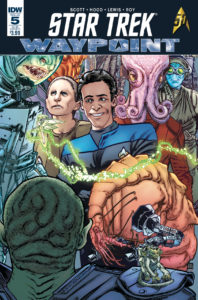
Star Trek: Waypoint #5
Writers: Cavan Scott/Simon Roy
Artists: Josh Hood/Simon Roy
Letterer: AndWorld Design
Publisher: IDW
 SCIENCE! In the early 1980s, Thomas Dolby once sang about a woman who blinded him with science. Today, Star Trek: Waypoint #5 brings readers two tales from the blue uniforms of Starfleet, better known as science division personnel. Experiencing any art form, whether it is literature, music, art, or comic books is difficult to do without considering the lens of the current environment in which it is experienced. It is interesting then, and perhaps even deliberate, that IDW Group and Star Trek Editor Sarah Gaydos chose these two stories for the latest in the anthology’s penultimate issue. Science has always been a guide to better understanding, and while there are currently those in the world that would dismiss scientific findings, the results from history are hard to dispute. Writers Cavan Scott (Deep Space Nine story) and Simon Roy (The Original Series) both use science to capture the heart of a classic Trek plot – humanity’s quest for knowledge.
SCIENCE! In the early 1980s, Thomas Dolby once sang about a woman who blinded him with science. Today, Star Trek: Waypoint #5 brings readers two tales from the blue uniforms of Starfleet, better known as science division personnel. Experiencing any art form, whether it is literature, music, art, or comic books is difficult to do without considering the lens of the current environment in which it is experienced. It is interesting then, and perhaps even deliberate, that IDW Group and Star Trek Editor Sarah Gaydos chose these two stories for the latest in the anthology’s penultimate issue. Science has always been a guide to better understanding, and while there are currently those in the world that would dismiss scientific findings, the results from history are hard to dispute. Writers Cavan Scott (Deep Space Nine story) and Simon Roy (The Original Series) both use science to capture the heart of a classic Trek plot – humanity’s quest for knowledge.
Star Trek: Deep Space Nine “Frontier Medicine”
“I didn’t want some cushy job or a research grant; I wanted ‘this’ – the farthest reaches of the galaxy, one of the most remote outposts available. This is where the adventure is. This is where heroes are made. Right here – in the wilderness.” – Doctor Bashir, “The Emissary”
Extracted directly from DS9’s pilot episode, Julian Bashir’s introduction to fans (and Major Kira) informed all of what was needed to know about the cocksure Starfleet officer, fresh out of the Academy. He chose the assignment on DS9 to practice frontier medicine; where heroes are made. Cavan Scott choice of season one Bashir to tell his anthology tale was an excellent lens in which to present his tale of misunderstanding in the quest of understanding.
“Frontier Medicine” feels reminiscent of another Star Trek pilot – Enterprise’s “Broken Bow,” in which Commander Tucker yells at a Lorillian woman attempting to wean her son off the chemical that assists him to breathe. T’Pol reminds him “to learn to objectify other cultures” so he knows when and when not to get involved. This idea is precisely behind Scott’s story, as DS9 has become the latest port of call to all sorts of new species.
Season One Bashir was a tad arrogant, and always reminded the Bajoran staff that he and his companions where there because they were the best (something Odo points out as well in the tale). Presented with a mystery, kidnapping and injury, the story centers around Bashir, Odo and Chief O’Brien assuming full response mode, as they attempt to protect the prey and subdue the assailant.
Creatively, both Scott and artist Josh Hood capture the characters voices and likenesses perfectly. Readers should easily hear Colm Meaney’s voice when he calls “Julian” as well as Terry Farrell’s when she addresses “Benjamin.” Plus, Hood’s illustrations reproduce the station’s magnificence, from its beautiful exterior to the expansive promenade, confined infirmary and multi-leveled ops. Hood’s action sequences are also commendable in eliciting the appropriate feelings of claustrophobia that comes in altercations in parts of the Cardassian-designed outpost.
Ultimately, Scott’s tale is one of overcoming preconceived notions and humility. After all, “… isn’t this what Starfleet is all about, ‘to seek out new life and new civilizations.’”
Star Trek: The Original Series “Come Away, Child”
Thirst for knowledge and obsession mark Waypoint’s second story, written and illustrated by Simon Roy. Instead of highlighting a medical doctor, Roy’s narrative focuses on a research scientist and an Enterprise Ensign. In fact, save for the opening panels, none of the TOS characters appear, which works for what Roy ultimately has in mind.
Whereas Scott’s DS9 tale had alien visitors coming to the protagonists, Roy’s story takes place in a “duck blind,” on a planet as Dr. Ganira Lewis observes a human/amphibious type species known as the Otarians. Her new assistant is Ensign Laura Herrada from the Enterprise, whom Spock notes “… performed all assigned tasks commendably.”
Scientists have a tendency to take calculated risks when attempting to understand their subjects. Generally, the risks grow when a scientist decides they can learn no more continuing on their present course. Every Star Trek fan knows the limitations in which Lewis operates under the Prime Directive, a fact in which Herrada must remind the singularly-focused scientist.
Penning an interesting an engaging tale, Roy is not hindered by character likenesses as he creates a new alien species and characters. While his art might not be the typical fare readers would come to expect with an officially licensed Star Trek story, it works for “Come Away, Child.”
Sacrifices are often made when it comes to matters of discovery. Just what sacrifices is Lewis and Herrada prepared to make to understand a new culture, and what, if any, repercussions will they face? Roy’s conclusion may surprise readers, but will also give them something to think about as they walk away – the mark of any terrific piece of art.
The Verdict
Buy It! Star Trek is at its best when it tells an allegory of the world as it is today. Gaydos decision to include two similar types of stories that show the need and lengths required to go to understand different cultures – whether they be an alien species in space or people of a different religion or region on Earth – make Star Trek: Waypoint #5 the finest of the series. Both Bashir, Lewis and Herrada are attempting to make a connection, develop a better understanding of the environments in which they live and much like the world today, discover they still have a ways to go.




One thought on “Star Trek: Waypoint #5 Review”